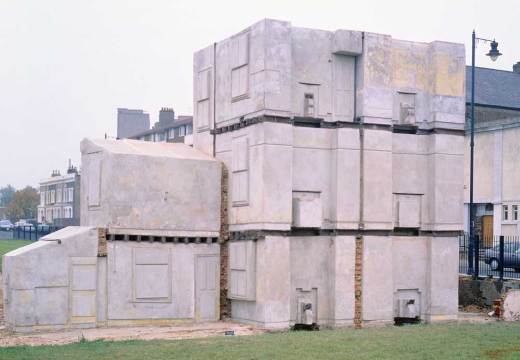The inexorable expansion of the contemporary art fair into a cultural jamboree continues with the 46th edition of Art Basel (18–21 June, with previews by invitation on 16 and 17 June). Determined to maintain its position as the world’s pre-eminent fair, in the face of stiffening competition from the London and New York editions of Frieze, this year’s Art Basel will feature an even wider programme beyond the main section, from film, lectures and performance to site-specific works and historical presentations.
Responding to the demands of time-poor art professionals that they provide a snapshot of the current state of contemporary art, as much as a platform for its sale, art fairs are increasingly encroaching upon the curated, thematic territories of biennials. This is most apparent in Art Basel’s decision to commission a large-scale installation for the Basel Messeplatz by artist Rirkrit Tiravanija, in collaboration with the Finnish chef Antto Melasniemi and German architects Nikolaus Hirsch and Michel Müller.
Art Basel is sponsored by UBS and its ‘associate partners’ include a high-end Swiss cigar manufacturer, a luxury watchmaker, and a private aviation company. That it should invite an artist whose declared aim is to ‘engage with the idea of artistic utopia’ neatly encapsulates the combination of high concept and high commerce that characterises the upper reaches of the contemporary art world. The press release informs us that Tiravanija’s artwork DO WE DREAM UNDER THE SAME SKY will consist of a ‘garden, kitchen, communal dining and meeting area’ at the entrance to the fair. Herbal tea and Thai food will be available with ‘no fixed schedule, menu or price list: compensation is self-determined, by self-serving, serving others, donations or even participating in the cooking or washing up.’ Visitors should note that these principles do not apply to the rest of the art on show.
Apart from providing an opportunity to make friends by washing dishes, Art Basel’s main draw is its central ‘Galleries’ section, which includes the world’s top galleries exhibiting the best work by their most sought-after artists. Among those who can be relied upon to provide fireworks are David Zwirner, Hauser & Wirth and Marian Goodman, each of whom continue to challenge the global commercial pre-eminence of Gagosian Gallery. In line with the industry-wide focus on developing markets in the BRIC countries and the Middle East, Basel makes much of the internationalism of its exhibitor list, but it’s notable that only three new galleries are included in the main arena.
Not content with providing the ‘traditional art fair stands’ in which dealers can arrange their wares, Art Basel also presents the ‘Unlimited’ section, for those works of art that ‘transcend’ such staples as walls and ceilings. In one of several instances of the growing cannibalisation by visual art over other cultural disciplines, Sprüth Magers brings underground American filmmaker Kenneth Anger to the party, while Gavin Brown’s Enterprise and Hauser & Wirth co-present Martin Creed’s Work No. 1701 (2013), a film documenting a variety of different walking styles, which sounds like a homage to Bruce Nauman’s silent film Walking in an Exaggerated Manner Around the Perimeter of a Square (1967–68).
Nauman himself, whose vast influence is beginning to be matched by the prices his work commands on the secondary market, is represented here by Konrad Fischer Galerie. The British artist Ed Atkins, who took part alongside Nauman in last year’s ‘14 Rooms’ project curated by Hans Ulrich Obrist, is in town with his London gallery Cabinet, whose indifference to press coverage is notorious among journalists.
Both Atkins and Nauman would, one suspects, contest the notion that their reliably witty, deadpan work ‘transcends’ anything, but their work will nonetheless be among the star attractions for those in the know.
Continuing a curatorial trend that stretches across art fairs to include museums and galleries, there seems to be an increased emphasis this year on the inclusion of historical works of art by canonical names. A number of these are gathered together in the ‘Feature’ section, the most interesting of which include an exhibition of works by the American avant-garde composer and artist John Cage, which are presented by James Cohan, and a group show of the Japanese Mono-ha artists who emerged in the 1960s and were recently brought to wider attention by a 2012 show at Blum & Poe Gallery. The inclusion of David Hammons, Yves Klein, Jean Tinguely, Daniel Spoerri, and Ulay reinforces the sense that Basel is competing not only with biennials, but also with major public institutions. There are few museums in the world with the resources to assemble such a line-up.
As the ‘Unlimited’ section transcends the fair, so the site-specific, performance-based Parcours programme promises to ‘permeate’ the city, suggesting that recent fears of a saturated art market may be more literally true than first thought. This is not even to mention the ‘Statements’ section – in which the young gun galleries are given the chance to impress (and audition for future inclusion on the main stage) – and the nonstop schedule of talks and panel discussions, the film programme, the concurrent Design Miami Basel (16–21 June), or even the fact that the nearby Fondation Beyeler has scheduled its blockbuster Gauguin exhibition to coincide with the fair.
Ben Eastham is the co-founder and editor of The White Review.
Art Basel is at Messe Basel, Messeplatz, from 18 to 21 June.

















![Masterpiece [Re]discovery 2022. Photo: Ben Fisher Photography, courtesy of Masterpiece London](http://zephr.apollo-magazine.com/wp-content/uploads/2022/07/MPL2022_4263.jpg)
‘Like landscape, his objects seem to breathe’: Gordon Baldwin (1932–2025)